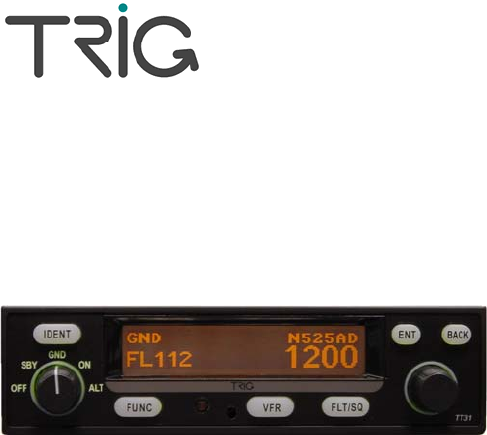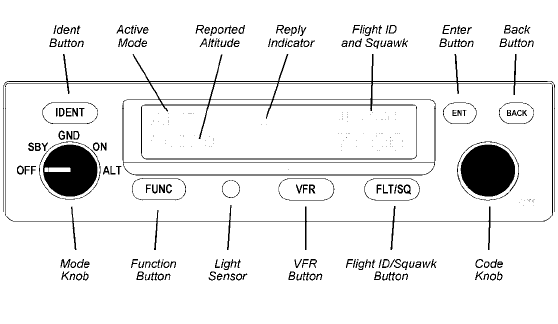Trig Avionics 00220 AVIATION SERVICES TRANSPONDER TRANSMITTER User Manual USERS MANUAL
Trig Avionics Limited AVIATION SERVICES TRANSPONDER TRANSMITTER USERS MANUAL
USERS MANUAL

TT31 Mode S Transponder
Operating Manual
00454-00-AA
1 September 2006
Trig Avionics Limited
Heriot Watt Research Park
Riccarton, Currie
EH14 4AP
Scotland, UK
© Copyright 2006

Front Panel
Display
The display shows the operating mode of the transponder, the
reported pressure altitude, and the current squawk code and Flight ID.
The reply indicator is active when the transponder replies to
interrogations.
The pressure altitude is displayed as a Flight Level, which is the
pressure altitude in hundreds of feet. When non-standard
atmospheric conditions apply, this may not match the altimeter
indicated altitude, but will be correctly displayed by the ATC radar.
Mode Selector Knob
The left hand knob controls the power to the transponder and the
operating mode.
OFF Power is removed from the transponder.
SBY The transponder is on, but will not reply to any interrogations.
GND The transponder will respond to Mode S ground interrogations
from surface movement radar.
ON The transponder will respond to all interrogations, but altitude
reporting is suppressed.
ALT The transponder will respond to all interrogations.
When airborne, the transponder should always be set to ALT unless
otherwise directed by Air Traffic Control. When you are taxiing on the
ground, the transponder should be set to GND unless your installation
includes a gear squat switch. Aircraft installations that include a gear
squat switch will automatically select GND on landing.
Push Buttons
IDENT Press the IDENT button when ATC instructs you to “Ident”
or “Squawk Ident”. This activates the SPI pulse in the
transponder replies for 18 seconds. IDENT will appear in
the display.
FUNC Pressing the FUNC button provides access to the flight
timer, stopwatch and altitude monitor function.
VFR Pressing the VFR button sets the transponder to the pre-
programmed conspicuity code. Pressing the button again
restores the previous squawk code.
FLT/SQ Pressing FLT/SQ alternates the primary display between
squawk code and Flight ID.
ENT The ENT button enters a digit in the code selector.
BACK The BACK button goes back to the previous digit in the
code selector.
Code Selector Knob
The right hand knob is used to set squawk codes and the Flight ID.
The FLT/SQ button selects which will be updated. Turning the knob
will highlight the first digit on the display, and the digit can be changed
as required. Press the ENT button to advance to the next digit. When
ENT is pressed on the last digit, the new squawk code or Flight ID will
replace the previous value. If the code entry is not completed within 7
seconds, the changes are ignored and the previous code restored.
1200 VFR code in the USA
7000 VFR code commonly used in Europe.
7500 Hijack code
7600 Loss of communications
7700 Emergency code
The Flight ID should correspond to the aircraft call sign entered on
your flight plan. If no flight plan is active, the aircraft registration
should be used as your Flight ID. Use only letters and digits. If the
Flight ID is less than 8 characters long, entering a blank character will
end it.
Flight Timer
The Flight Timer records the time for which the transponder has been
powered on and operating in flight mode – either ON or ALT. Press
the FUNC button to display the Flight Timer.
Stopwatch
The stopwatch can be used as a convenient timer. Press the FUNC
button to display the stopwatch. Pressing ENT will reset and start the
timer. Pressing ENT again will stop the timer.
Altitude Monitor
The Altitude Monitor activates an audio annunciator or annunciator
light (depending on installation) when the aircraft pressure altitude
differs from the selected altitude by more than 200 feet. Press the
FUNC button to display the altitude monitor enable screen. Pressing
ENT toggles the altitude monitor at the current altitude.
When altitude monitoring is in use, a small deviation pointer appears
adjacent to the altitude display on the transponder.
Fault Annunciation
If the transponder detects an internal failure, the screen will indicate
FAULT and a brief statement of the problem. No replies will be made
to interrogations when a fault is detected.
Configuration Mode
The system is configured when it is first installed by your avionics
supplier. Configuration items include the Mode S aircraft address, the
aircraft category, and the pre-programmed values for VFR squawk
code. To view or change these settings you must use Configuration
Mode.
Do not use Configuration Mode in flight. Check with
your avionics installer before changing the
configuration.
To enter configuration mode, hold down the FUNC button whilst
switching on the transponder. Configuration items can be changed
using the Code Knob and the ENT and BACK buttons. Pressing
FUNC advances to the next configuration item.
When configuration is complete, switch the transponder off. When it is
switched back on the transponder will use the new configuration.
Low Temperature Operation
The TT31 is certified to operate correctly down to -20C, but at low
temperatures the display may be impaired. On a cold day you may
need to wait for the cockpit to warm up to ensure normal operation.
Trig Avionics Limited
Building 4, Heriot Watt Research Park
Riccarton, Currie EH14 4AP, UK
Tel: +44 (0)131 449 8810
Fax: +44 (0)131 449 8811
support@trig-avionics.com
www.trig-avionics.com